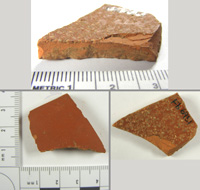Samian mortaria

Click ^ for larger image.
Samian pottery was imported high status Roman fine tableware with distinctive brick red colour and very smooth burnished surface. The mortaria was an essential kitchen utensil for creating Roman recipes. The shape was hemispherical or conical often with a flanged lip for pouring. The rough inner surface of grit was used to grind or puree foodstuffs; smallish items, maybe fruits or herbs and may have been used during dining rather than in the kitchen. Interestingly, mortaria appeared in Britain even before the Romans arrived, suggesting that Roman style food was already on the menu for some people. Possibly 2nd century.
Found at Brislington Roman villa site during the development of what is now Winchester Road in December 1899. The villa is contemporary with several others in the region, built about AD 270 as a working farm with workshops until destroyed by fire about AD 370.
Photographs exhibited with kind permission of Bristol Museum and Art Gallery, which has this artefact in its collection (reference number Fb6951).
Material: ceramic
Period: Romano-British
Find spot: Winchester Road, Brislington. ST 616709
Exhibit contributed by Bristol Museum and Art Gallery
Text written by Dawn Witherspoon, 2012
Photographer: Ken Taylor
Acquisition number: 120316c3